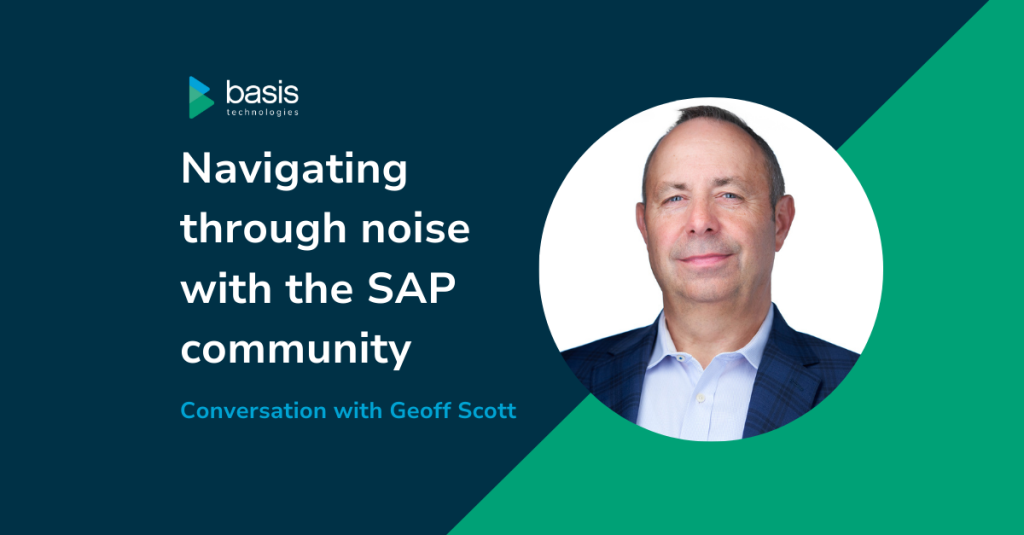
We recently sat down with Geoff in the run up to SAP Sapphire & ASUG Annual Conference that will be held in Orlando to understand the vital role community plays for SAP customers navigating their way through daunting updates, conflicting advice, and changing business landscapes.
Q: What’s the big topic in the SAP community this year?
A: I think the question everyone is asking themselves is, what does the next generation of cloud ERP look like? And should my organization (or IT team) care?
At ASUG, we think you should absolutely care about cloud ERP. The pandemic has changed the way commerce is done globally. Customers want to interact digitally with their suppliers, partners, and whoever they buy from, whether that’s B2B or B2C. This necessitates that your SAP systems are tuned to high volume, low latency commerce. People want to place an order and get a response back immediately. That’s why S/4HANA, whether public or private cloud, makes sense as we move to this next generation in cloud ERP.
Q: What advice do you give people who want to prepare their SAP systems for the new way of doing business?
A: We live in a world where digital transformation is an absolute necessity. If you want to be able to compete with your competitors (and everyone does), and you want to be able to innovate faster (which everyone does), you need to think about 3 things.
- Get your SAP infrastructure on the cloud so you can dial it up and down at speed.
- Think of your ERP solution as a SaaS-based product – moving the management of the core software outside the business with automation providers like Basis Technologies so you can focus on business transformation.
- Reduce or eliminate customizations – having a very tight governance on why you’re making customizations to your ERP. Are they really driving business outcomes or is it convenient because no one wants to implement change management?
Once you have cloud, SaaS, and low customization, you can move along the innovation curve and adapt faster. This way SAP is keeping pace with your business, and maybe even leading it, rather than holding you back because you don’t have the infrastructure in place to run at the speed of your future customer base’s demands.
Q: Why do you think community plays such an important role in the SAP space?
A: Whether you’re a CIO, Enterprise Architect, Basis or ABAP Lead, you’re dealing with more noise about SAP than ever before. Everyone is coming with different perspectives on the best way they should be innovating. User communities, like ASUG, enable people to make sense of this noise by allowing them to talk with their peers going through the same situations as them, hearing what made them successful.
One thing we hear time and time again is that user communities are one of their most trusted go-to sources of information. While the core reason user communities exist is for people to find answers, I’ve found that it’s the human need to seek out community and friendship that keeps people coming back.
We operate 38 regional chapters in North America and the interest we’re seeing from people who want to attend their local chapter meetings is incredibly high right now. What was amazing about Sapphire in 2022, which was the first time we got everyone back together after the pandemic, was the energy and reaction from everyone simply seeing their peers, coworkers and, friends for the first time in a long time. When people go to SAP Sapphire and ASUG Annual Conference this year, they’re not just going to see the keynotes, they’re going to see their friends who they only see twice a year. That’s the essence of community.
Q: We’re fast approaching some key deadlines in 2027 for SAP customers. Is the community on track to hit them?
A: I’m shocked that I still hear people ask: Is 2027 real? Is it going to get pushed back?
2027 is very real. As we get closer to that deadline, the most important thing to accept is that you’re not going to be able to do a whole scale migration. You’re going to need to find tools and techniques to automate and mechanize what you’re doing. It’s why companies like Basis Technologies exist, because you’re not going to get this done the old-school way.
While no one is going to take your ECC systems away, why would you want to hold onto them? The analogy that I use is the iPhone. No one is forcing you to use the latest iPhone, but many of us stay within one or two generations of the latest model. If I gave you an iPhone6, you’d think it’s a useless piece of technology. You could take phone calls, but your apps wouldn’t work because the compatibility and technical support is no longer there.
I want to be clear that I understand the complexity that most customers are going through with enterprise ERP. I get that your ERP is not as simple as an iPhone upgrade. These upgrades shouldn’t be as time-consuming, risky, and costly as they are, but it’s the reality we’re faced with. The first step is accepting that 2027 is real. The second step is asking yourself what you’re going to do about it.
Q: Why does automation make the S/4HANA migration less daunting?
A: Honestly, I don’t know how you migrate to S/4 without automating. Automation drives better consistency. If we automate something, we know it will be repeatable. I can’t tell you how many customer conversations I’m in where they get through data validation and everyone says, “thumbs up, data looks good” and they push through the migration to find out the data wasn’t as good as they thought. Suddenly they can’t invoice, can’t close their books, etc. When you rely on a human to say whether the data is good or not, mistakes are inevitable. Automation tools validate that the data coming into the migration process is clean and safe, which I think is a huge leg up on the competition.
Q: What are the consequences of not looking into automation?
A: Automation should be the baseline in SAP updates. It ensures that your desired outcome is guaranteed, it reduces manual work, and it improves efficiency. The SAP nervous system has become much more important in recent years. When I talk to most leaders today, it’s clear that if their SAP infrastructure is not operating well, it has immense and tangible impacts on the ability of the enterprise to execute.
If SAP went down 15 years ago, you could keep a plant running for a while. You still downloaded orders to the plant and there was infrastructure there to handle it. It was complicated, but it worked. In the modern enterprise, a lot of those layers have been taken out because everything’s done over the internet. The amount of time to business failure when SAP goes down has shortened. As SAP practitioners, we can’t afford for SAP to go down because when it does, business stops. It’s incredibly expensive and the damage it does in restart is significant. In that lens, how can you afford not to look at automation tools?
Q: SAP Sapphire and ASUG Annual Conference are right around the corner. What should people expect?
A: SAP Sapphire and ASUG Annual Conference has been a partnership for over 20 years. If you want to understand what’s going on in the SAP ecosystem, if you want to meet with all your partner and customer connections, there’s no better place to do it than in Orlando at Sapphire. It is the seminal SAP event of the year.
Even if you feel like you don’t need any of that, I’d urge you to go anyway and to watch and to listen and to find that community and friendship that in-person events like this provide. Introduce yourself to multiple partners, customers, and those of us from ASUG who you’ve never met in person before. Hear what they have to say and think about how that would impact your strategies and directions.
People who attend should expect to learn, connect, and grow at the main event and at our ASUG Pre-Con sessions. They will leave the event with a greater sense of community and a great understanding of where SAP is going, where AI is going, and what their peers are doing about it. It’s a minimal investment with immense payback.
Join us on June 4th for our Sapphire VIP Reception, sponsored by IBM, smartShift, and SNP, to dive into this topic and more.








